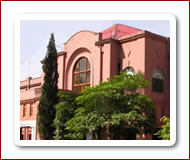| Department of Theriogenology |
IntroductionThe Department of Theriogenology was established in 1980; then known as Department of Animal Reproduction. Theriogenology relates to the branch of veterinary medicine that encompasses the basic physiology and pathology of male and female reproductive systems, the applied and clinical practice of veterinary obstetrics, gynecology and andrology and the application and implementation of advanced animal reproductive biotechnologies. Objectives The primary objective of the department is to impart teaching and training of undergraduate and postgraduate students enrolled in DVM, MPhil and PhD degree programs. In parallel, it provides clinical and extension services to the animal breeders and farmers. Last, but not the least, the department has a rich tradition of conducting trainings and workshops for veterinarians, paravets, farmers and different stakeholders of the industry. The department intends to create inclusive environment for its graduate students and faculty to interact, enhance capacity building, and strengthen the postgraduate program under the platform of “Theriogenology Graduate Club (TGC)”. The department also houses the secretariat of Society for Animal Reproduction of Pakistan (SARP), the only platform for veterinary professionals excelling in the field of theriogenology. Research PrioritiesThe department has set its research priorities in order that basic, applied and, more importantly, problem oriented research be conducted by the postgraduate students:
ENHANCEMENT MEASURESThe undergraduate and postgraduate courses have been revised and updated according to the new scheme of study as approved by the FVS and DAS. New and separate courses for MPhil and PhD have been introduced. The laboratories have been upgraded; the undergrad lab is equipped with state of the art CASA (computer assisted sperm analysis) and IVEP lab with high-end embryo culture gadgets. The old lecture room has been renovated, the clinics been well equipped and experimental sheds been extended.
|


